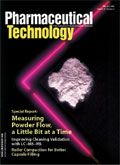Phase 0 Sets Stage for Bigger Pipelines
I rarely talk science on the weekends. I spend a good deal of that free time with friends from college performance groups. The conversation centers more on choreography and piano concerti than on CGMPs and chemical reactions. So it always throws me for a loop when these theater and music buffs drop pharmaceutical news into casual conversation.
I rarely talk science on the weekends. I spend a good deal of that free time with friends from college performance groups. The conversation centers more on choreography and piano concerti than on CGMPs and chemical reactions. So it always throws me for a loop when these theater and music buffs drop pharmaceutical news into casual conversation.

Kaylynn Chiarello-Ebner
Last week, a saxophone-playing friend brought up FDA's new initiative to allow microdose testing in humans. The proposal is part of the agency's Critical Path Initiative, intended to help refill the dwindling pipeline of new products. Only 20 new drugs received FDA approval in 2005. FDA's draft guidance, "Exploratory IND Studies," would allow Phase 0 testing of new drugs in very low doses on humans sooner in the development process. The hope is to bring more drugs through trials and to market faster.
The reaction from this circle of arts devotees was strong and diverse: my flute duet partner argued that early drug trials could put human volunteers at risk for life-threatening side effects. The saxophonist was insistent that a "cozy" FDA–industry relationship might compromise public safety to beef up pipelines and profits.
But, a fellow ballet instructor retorted that the initiative is a positive step toward gathering more information about a drug's activity before entering Phase I. In turn, companies could bring stronger candidates sooner, without wasting time and money on failed early trials. Microdoses, she argued (unwittingly echoing FDA Deputy Commissioner Janet Woodcock), would probably be too small for a subject to feel their effects.
Phase 0 trials are a gamble either way. What will be interesting to see is how many drugs make it through the first auditions and are more prepared to take the stage in later trials. Could this be an instance for which we look back in years to come and give the initiative rave reviews for its forethought?
Kaylynn Chiarello-Ebner is the managing editor of Pharmaceutical Technology, kchiarello@advanstar.com

Drug Solutions Podcast: A Closer Look at mRNA in Oncology and Vaccines
April 30th 2024In this episode fo the Drug Solutions Podcast, etherna’s vice-president of Technology and Innovation, Stefaan De Koker, discusses the merits and challenges of using mRNA as the foundation for therapeutics in oncology as well as for vaccines.
Drug Solutions Podcast: Gliding Through the Ins and Outs of the Pharma Supply Chain
November 14th 2023In this episode of the Drug Solutions podcast, Jill Murphy, former editor, speaks with Bourji Mourad, partnership director at ThermoSafe, about the supply chain in the pharmaceutical industry, specifically related to packaging, pharma air freight, and the pressure on suppliers with post-COVID-19 changes on delivery.